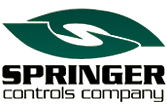A magnetic motor starter is an electromagnetically operated device that starts and stops a connected motor load. Magnetic starters consist of an electrical contactor and an overload which provides protection in case of a sudden loss of power.

Contactor vs Relay
The contactor is similar to a relay but is designed to switch a larger amount of electrical power and handle higher voltage loads. Unlike a relay, a contactor does not have an energized common pole which switches between the normally open and normally closed poles. The contactor consists of a contact carrier with electrical contacts to connect the incoming line power contact to the load contact, an electromagnet (commonly referred to as the “coil”) which provides the force to close the contacts to allow current to flow, and the enclosure which is an insulating material to hold the parts together and provide some measure of safety against a person touching the terminals. Contactors are typically made with normally open contacts, meaning the power will not flow to the load until the coil is activated, which closes the contactor. Coil activation is typically done by a control operator, either manual, i.e. a person pushing a button/flipping a switch, or automatically using a sensor, or timer which switches when a particular condition is reached. Contactors can be provided with auxiliary contacts (either normally open or normally closed) to perform additional operations when the contactor is closed.
When the contactor is closed, this allows current to go to the “coil” (electromagnet). This can be the same voltage as the power going through the contacts, or often a lower “control” voltage is used only to energize the coil. When the coil is energized, this creates a magnetic coupling between the contacts & contact carrier, allowing them to stay together and current to flow to the motor or other load until the system is shut off by de-energizing the coil. When de-energized, a spring causes the contacts to separate and halt the flow of power through the contacts, thus turning off the motor or load.
Thermal Overload Relay: What is Is and How it Works
The thermal overload relay is designed to protect the motor or other load from damage in the event of a short circuit, or being over-loaded and overheating. The simplest overload relay is activated by heat caused from high current flowing through the overload and over a bimetallic strip. A bimetallic strip is a band of two different metals attached to each other where each metal has a different coefficient of thermal expansion. As this bimetallic strip heats up, one metal will expand faster than the other and cause the assembly to curve. When it gets hot enough the curvature will be enough for the contacts in the overload to become separated. Since the overload has a contact wired into the control circuit of the contactor, this effectively breaks the circuit and de-energizes the system. Once the bimetallic strip cools, it will straighten out and allow the circuit to close again.

Overload Relay Operational Modes
Overload relays may be set for 4 different operational modes.
- Manual Reset Only – where an operator must press the button to restart the system. This setting is commonly used for safety reasons to ensure the system will not restart on its own.
- Automatic Reset Only – where as soon as the bimetallic strip cools, the system will automatically restart. This is useful when the system is in a remote location, making it difficult to manually restart, and automatic restart is unlikely to create a dangerous condition.
- Manual Reset / Stop – Similar to Manual Reset Only, but allows the button to be used to manually stop the system. This is useful for simple systems where a separate off switch is not necessary.
- Automatic Rest / Stop – Similar to Automatic Reset Only, but allows the button to be used to manually stop the system. This is useful for simple systems where a separate on/off switch is not necessary.
Overload relays are generally compensated for ambient temperature and the trip setting is often adjustable within a relatively narrow range. Older overload relays are available with fixed temperature trip points using bimetallic strips. These are commonly called “heaters” and are specific for each trip point (current). Newer overload relays are available with electronic control and are used for multiple motor functions.
Still have questions about magnetic motor starters?
If you still have questions about magnetic motor starters and their applications, the experts at Springer Controls are here to help. Contact us today and we’ll be glad to assist you!
